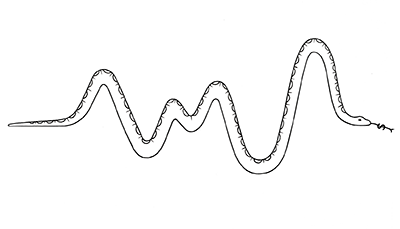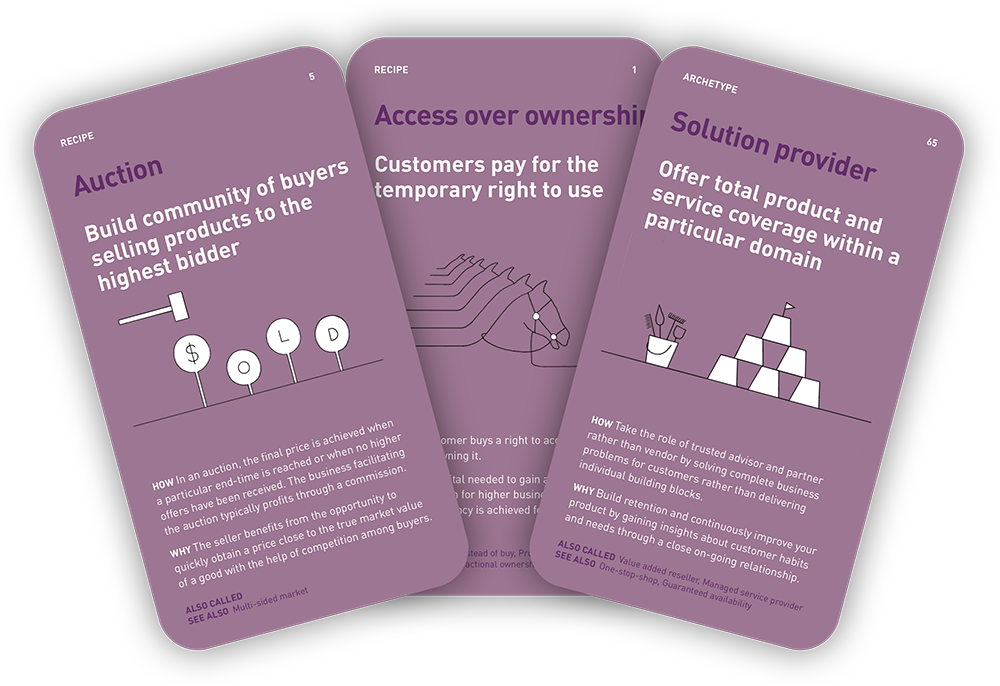Element
Also called: Real-time pricing
| Key Partners | Key Activities | Value Propositions | Customer Relationships | Customer Segments | |||||
| Key Resources | Channels | ||||||||
| Cost Structures | Revenue Streams | ||||||||
How: Vary pricing for products or services based on different demand variables such as purchase demand, time, customer segment, or season.
Why: Dynamic pricing can help even out capacity bottlenecks, utilizing as many available resources as possible.
This business model is part of the Business Model Patterns printed card deck.
A collection of business models that will help you understand the key drivers of business model success. The card deck will be ready for purchase in the end of 2023 and is now undergoing rigorous testing.
Reserve your deck!Dynamic pricing is a strategy that allows businesses to adapt and respond to changing market conditions. By using software agents to gather data and adjust prices in real-time, businesses can take advantage of fluctuations in demand to maximize their profits.
Retailers have two primary options for pricing strategies: static and dynamic.
- Static pricing involves setting a single, fixed price point for a product.
- Dynamic pricing involves using multiple price points and continuously adjusting prices in response to market conditions.
Examples of where dynamic pricing is in full play include:
- Buying tickets for events or travel
- Reserving accommodation online
- Ordering a ride from a service like Uber
Dynamic pricing allows businesses to be more responsive to changing market conditions and customer demand. By adjusting prices in real-time, businesses can optimize their profits and better meet the needs of their customers. In a rapidly changing market, dynamic pricing can be a valuable tool for businesses looking to stay competitive.
Applying the Dynamic Pricing business model
Using algorithms and business rules, software agents analyze this data and automatically adjust prices accordingly. Recently, machine learning-based pricing technologies have emerged that can significantly improve the effectiveness of price optimization. These advanced pricing solutions are able to forecast the impact of price changes before they go into effect, leading to higher profits and a competitive edge for retailers that adopt them. This allows businesses to respond quickly to shifts in demand and optimize their pricing strategy.
Common Input Factors
There are many factors that can be used as input or triggers for price changes. Some of the most common include:
- Supply: This is a common factor in industries with a high proportion of fixed costs, such as hotels, airlines, and ride-sharing companies. As the amount of available supply (e.g. seats, rooms) decreases, prices tend to increase. In retail, supply is particularly important for stock items, particularly if they are perishable or cannot be sold after a certain time frame (e.g. fashion products). Retailers must therefore optimize prices over the entire lifecycle and available stock of a product.
- Demand: An increase in demand for a product can trigger a price increase. Retailers using this strategy aim to capture a larger share of their customers’ willingness to pay. A classic example is a popular brand of sneakers. In extreme cases, we may see price gouging, where sellers take advantage of demand spikes. For instance, face mask prices increased significantly during the COVID-19 pandemic.
- Competitor prices: Competitor prices are frequently used in online retail as a primary factor to trigger price changes. It is especially easy for customers to compare prices when competitors sell the same product. However, it can be difficult to determine which products are truly price-comparable and at what price difference customers are willing to switch vendors.
- Customer characteristics: This form of dynamic pricing is often referred to as personalized pricing, where prices vary for different types of customers. The idea is that different customers have different willingness to pay and can therefore be charged different prices. For example, a museum may offer a discount for senior citizens. In online retail, personalized pricing is often implemented through the use of coupons. Companies that use this form of dynamic pricing must be mindful of potential backlash from customers who feel the pricing is unfair.
Trigger Questions
- What parameters (demand, time, location, inventory, etc.) can you use to justify that some customers are charged more than others?
- And is dynamic pricing legal in your sector?
- How can you leverage customer data, and what data points will you use to construct the pricing curve
Examples
AirBnB
Once enabled by the seller, Airbnb changes rents to match supply and demand in the area to ensure maximum occupancy.
SF Park
Higher parking prices in overused areas and garages encourage drivers to park in underused areas.
- 26 Revenue model cards (B2C) by Board of Innovation

